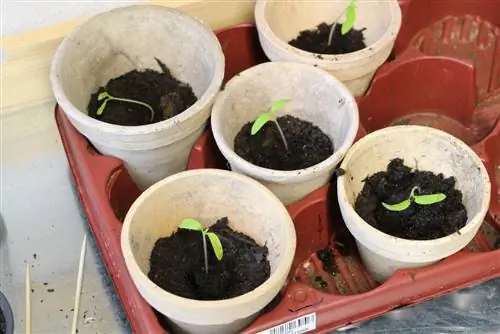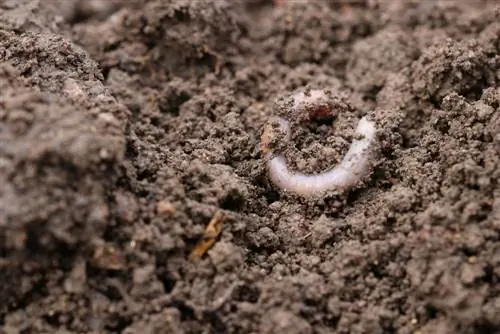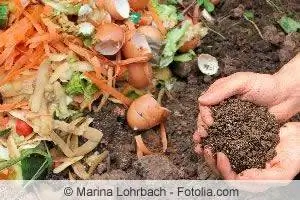- Author admin [email protected].
- Public 2023-12-17 03:39.
- Last modified 2025-01-24 12:45.
The criteria for purchasing decisions have changed. In addition to the price and properties of the product, environmental aspects are also increasingly playing an important role. Most commercially available potting soil is no longer considered safe. It contains large proportions of raised bog peat. Raised bogs, however, fulfill an ecological function and should remain untouched. But the preference for peat persists. Is he really irreplaceable?
What is raised moor peat anyway?
Moors are water-saturated and oxygen-poor landscapes. Under these conditions, microorganisms can only break down the dead plant material into its components very slowly. The partially decomposed plant material accumulates over time and forms peat. A raised bog no longer has a connection to groundwater and is only supplied with moisture from precipitation.
The first stages of decomposition produce white peat, which is actually light brown. Plant remains can still be clearly seen in it. Black peat is the last stage of decomposition that still has the properties of loose soil. Because dried peat is combustible, it was once widely used for heating. It is therefore still common today to classify peat according to its calorific value. The higher the value, the more the plant material is decomposed.
Properties of raised bog peat
White peat is usually used for potting soil because it has a coarser structure than black peat. This makes the planting substrate looser. Black peat is also rarely included. Both types of peat are low in nutrients and acidic. This is how low their pH value is:
- White peat has a value between 3 and 4
- Black peat has a value between 5 and 6
Why peat is used?
All plants need nutrients and usually a not too acidic environment to grow. Peat has neither to offer. That's why it's surprising why it has become so widespread. However, its price has been low for decades, which makes it attractive for retailers. In addition, it is easy to dismantle and easy to pack and transport. The following reasons are given for its use:
- good starting material, thanks to uniform composition
- its structural stability supports plant roots
- can store and release water and nutrients
- is largely free of pathogens and seeds
- the loose structure offers good oxygen supply

Low nutrients and low pH values do not represent an insoluble problem for the industry. Nutrients are simply added in the desired composition and concentration. And by adding lime, the acid is neutralized.
Note:
The mining companies do not provide any financial compensation for the destruction of the raised bogs.
Self-mixed plant substrate
If you mix your soil yourself at home and use peat, your plants can benefit from its physical properties such as looseness and structural stability. But you also have to find a solution to the “acidic” problem and the lack of nutrients yourself. This requires the use of additional materials or additional fertilizer as well as lime to neutralize the acid. Since none of us are chemical laboratory technicians, an optimal composition can hardly be achieved exactly.
The criticisms of environmentalists
It takes about a thousand years for peat to form from plant remains. The peat bog layer grows by only one millimeter annually. In contrast, we humans are record holders when it comes to mining speed. Although the moor is growing, it cannot nearly compensate for the degradation in a timely manner. As a result, raised bog areas shrink and disappear irretrievably.
But why is the moor so important? These are the reasons:
- The moor areas make up about 3% of the earth's surface
- but they store 30% of the earth's CO2
- this is an important contribution to climate protection
- Moors store water
- they release it slowly into the groundwater
- that counteracts flooding
- the moor is a valuable habitat
- Plants and animals that specialize in it can only exist there
Note:
Peat is mined cheaply, especially in Eastern Europe. He has to travel the long way to us on trucks. Along with other environmentally harmful substances, a lot of climate-damaging CO2 gas is also emitted.
Peat-reduced products
There is now soil on the market that is offered with a reduced peat content. This is intended to satisfy environmentally conscious buyers and encourage them to buy. In fact, the proportion of peat has been reduced, but the amount of peat contained is still extremely high. Instead of 100%, it is “only” 80%. Everyone can decide for themselves whether they think this reduction is sufficient or whether they see the whole thing as a pure marketing move.
What does a substitute have to offer?

Alternative ingredients for potting soil should of course themselves be environmentally friendly and sustainable. In addition, they should particularly offer the properties for which peat is so valued. This includes the ability to provide loose potting soil. Furthermore, nutrient-poor soil is required for cultivation. For plants that prefer acidic soil, the lower pH value must be achieved in another way.
Peat-free soil from stores
It also exists, although currently with a modest market share: the completely peat-free potting soil. Its composition consists of the following natural materials that make peat unnecessary:
- Bark humus
- Fibers from wood, coconut, miscanthus or hemp
- with additions of lava granules, sand or clay minerals
Tip:
Coconut palm growing areas are far away from us. The long transport route is anything but climate-friendly. Environmentally conscious gardeners also avoid potting soils that contain this substance.
Alternatives for peat
Potting soil doesn't always have to be expensive and time-consuming to get from the garden center. Anyone can mix together a good planting substrate at home. The composition depends on the intended use. However, many recommendations require the addition of peat. Depending on what function the peat is supposed to fulfill, an alternative substance can be used.
- a portion of sand loosens solid soil
- Xylitol or bark mulch are also suitable for this
- Compost also provides plenty of nutrients
- Grape esters lowers the pH value
- alternatively special, acidic compost
- Expanded clay provides water and ventilation
Low-nutrient potting soil is usually required for cultivation. This can be achieved by adding perlite and coconut humus.
Tip:
Don't just pay attention to peat-free substrate. Other products such as small growing pots can also be made from peat.
Use peat carefully?
The recommendation here could be to use peat only as an exception and only in small quantities. But given that peat can be replaced, there is no reason for this. Of course we can and may use up the peat we have already purchased. Rhododendrons and azaleas, for example, will benefit from it as they like acidic soil.






